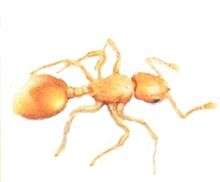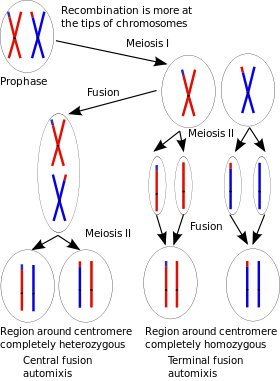Electric ant
| Electric Ant | |
|---|---|
 | |
| Electric Ant | |
| | |
| Actual size of electric ant | |
| Scientific classification | |
| Kingdom: | Animalia |
| Phylum: | Arthropoda |
| Class: | Insecta |
| Order: | Hymenoptera |
| Family: | Formicidae |
| Subfamily: | Myrmicinae |
| Genus: | Wasmannia |
| Species: | W. auropunctata |
| Binomial name | |
| Wasmannia auropunctata (Roger, 1863) [1] | |
The electric ant, also known as the little fire ant, Wasmannia auropunctata, is a small (approx 1.5 mm long), light to golden brown (ginger) social ant native to Central and South America, now spread to parts of Africa (including Gabon and Cameroon), North America, Puerto Rico,[2] Israel,[3][4] Cuba, and six Pacific Island groups (including the Galápagos Islands, Hawaii, New Caledonia and the Solomon Islands) plus north-eastern Australia (Cairns),[5][6]
The name, electric ant (or little fire ant) derives from the ant's painful sting relative to its size.[7] This ant's impact in those environments and countries outside of its place of origin has been described as follows:[6]
Wasmannia auropunctata .. is blamed for reducing species diversity, reducing overall abundance of flying and tree-dwelling insects, and eliminating arachnid populations. It is also known for its painful stings. On the Galápagos, it eats the hatchlings of tortoises and attacks the eyes and cloacae of the adult tortoises. It is considered to be perhaps the greatest ant species threat in the Pacific region.

Description
The ant is described as follows:[6]
"..Wasmannia auropunctata workers are monomorphic, which means they display no physical differentiation... The ants are typically small to medium-sized, with the workers ranging from 1-2mm ... [It] is light to golden brown in color. The gaster is often darker. The pedicel, between the thorax and gaster, has two segments; the petiole and postpetiole. The petiole is "hatchet-like", with a node that is almost rectangular in profile and higher than the postpetiole. The antennae have 11 segments, with the last two segments greatly enlarged into a distinct club. The antennal scape (the first segment) is received into a distinct groove (scrobe) that extends almost to the posterior border of the head. The thorax has long and sharp epinotal spines. The body is sparsely covered with long, erect hairs. This species is well-known for a painful sting, seemingly out of proportion to its size."
Reproduction
In Wasmannia auropunctata, queens produce more queens through parthenogenesis. Sterile workers usually are produced from eggs fertilized by males. In some of the eggs fertilized by males, however, the fertilization can cause the female genetic material to be ablated from the zygote. In this way, males pass on only their genes to become fertile male offspring. This is the first recognized example of an animal species where both females and males can reproduce clonally resulting in a complete separation of male and female gene pools.[8][9]
These ants get the benefits of both asexual and sexual reproduction[8][10] - the daughters who can reproduce (the queens) have all of the mother's genes, while the sterile workers whose physical strength and disease resistance are important are produced sexually.
Automixis
Parthenogenesis is a natural form of reproduction in which growth and development of embryos occur without fertilization. Thelytoky is a particular form of parthenogenesis in which the development of a female individual occurs from an unfertilized egg. Automixis is a form of thelytoky, but there are several kinds of automixis. The kind of automixis relevant here is one in which two haploid products from the same meiosis combine to form a diploid zygote.

W. auropunctata thelytokus queens from clonal populations can reproduce by automictic parthenogenesis involving central fusion of haploid meiotic products, a process that allows conservation of heterozygosity in progeny.[11] The same parthenogenic queens that produce progeny by automixis may also produce normally segregating meiotic oocytes, which upon fertilisation by males give rise to diploid workers.
The oocytes that undergo automixis display much lower rates of crossover recombination (by a factor of 45) than the oocytes produced by sexually reproducing queens that give rise to workers. These low recombination rates in automictic oocytes favor maintenance of heterozygosity, and allow only very low rates of transition from heterozygosity to homozygosity (0 to 2.8%).[11] The sharp decrease in recombination rates likely allows clonal queens using automixis to benefit from thelytoky (transmission of their entire genomes to individual progeny), while also avoiding the potential for inbreeding depression that would result from random fusion of meiotic products leading to loss of heterozygosity.
In general, parthenogenesis appears to be favored in recently disturbed habitats (such as produced by floods, fires and glaciers).[12] The clonal populations of W. auropunctata are mostly found in habitats disturbed by recent human activity.[11]
Keratopathy
There is a strong suspicion of a link between Florida keratopathy or Tropical keratopathy and presence of W. auropunctata.[13]
References
- ↑ "Wasmannia auropunctata". Integrated Taxonomic Information System.
- ↑ http://www.fs.fed.us/r8/caribbean/wildlife-facts/2010/wildlife-facts-may-2010.shtml
- ↑ Vonshak, Merav; T. Dayan; A. Ionescu-Hirsch; A. Freidberg; A. Hefetz (2010). "The little fire ant Wasmannia auropunctata: a new invasive species in the Middle East and its impact on the local arthropod fauna". Biological Invasions. 12: 1825–1837. doi:10.1007/s10530-009-9593-2.
- ↑ Foucaud, Julien; et al. (2010). "Worldwide invasion by the little fire ant: routes of introduction and eco-evolutionary pathways". Evolutionary Applications. 3: 363–374. doi:10.1111/j.1752-4571.2010.00119.x.
- ↑ Electric ant (Wasmannia auropunctata) webpage Accessed 7 March 2009
- 1 2 3 Global Invasive Species Database - No. 100 - Wasmannia auropunctata
- ↑ Queensland Government Electric Ant: Warning Accessed 7 March 2009
- 1 2 Fournier, Denis; Estoup, Arnaud; Orivel, Jérôme; Foucaud, Julien; Jourdan, Hervé; Breton, Julien Le; Keller, Laurent (2005). "Clonal reproduction by males and females in the little fire ant". Nature. 435 (7046): 1230–4. doi:10.1038/nature03705. PMID 15988525.
- ↑ Queller, David (2005). "Evolutionary Biology: Males from Mars". Nature. 435 (7046): 1167–8. doi:10.1038/4351167a.
- ↑ Pearcy, M.; Aron, S; Doums, C; Keller, L (2004). "Conditional Use of Sex and Parthenogenesis for Worker and Queen Production in Ants". Science. 306 (5702): 1780–3. doi:10.1126/science.1105453. PMID 15576621.
- 1 2 3 Rey O, Loiseau A, Facon B, Foucaud J, Orivel J, Cornuet JM, Robert S, Dobigny G, Delabie JH, Mariano Cdos S, Estoup A (2011). "Meiotic recombination dramatically decreased in thelytokous queens of the little fire ant and their sexually produced workers". Mol. Biol. Evol. 28 (9): 2591–601. doi:10.1093/molbev/msr082. PMID 21459760.
- ↑ Bernstein H, Byerly HC, Hopf FA, Michod RE (1985). "Sex and the emergence of species". J. Theor. Biol. 117 (4): 665–90. doi:10.1016/S0022-5193(85)80246-0. PMID 4094459.
- ↑ Theron, Leonard (2005). "Wasmannia auropunctata linked keratopathy Hypothesis - The Polynesian Case". Doctorate in Veterinary Medicine Master. hdl:2268/652.
External links
| Wikimedia Commons has media related to Wasmannia auropunctata. |
| Wikispecies has information related to: Wasmannia auropunctata |
- University of Hawaii Alert: "Identifying the Little Fire Ant" (includes photo)Accessed 8 March 2009
- Little Fire Ant in French Polynesia